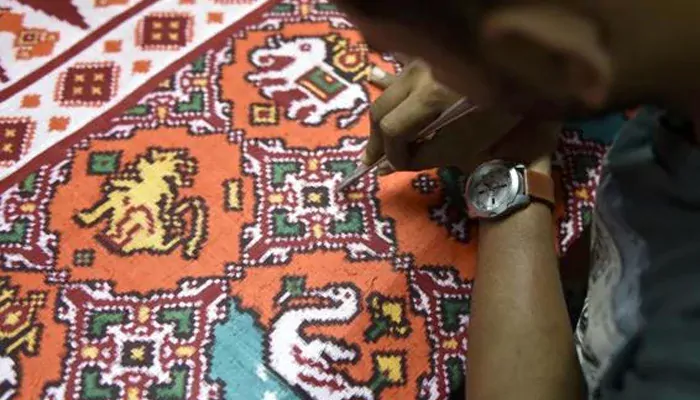
Forget boring battle plans – India's freedom fighters whispered rebellion through breathtaking silk! Unravel the secret language hidden in Gujarat's legendary Patola sarees.
Okay, picture this. You're in British Raj India. Freedom fighters are buzzing, planning, and needing to talk. But spies are everywhere. Letters? Risky. Meetings? Dangerous. So, what’s the solution? How about... your grandma’s favourite silk saree? Sounds wild, right? But hold onto your dupattas, because legend has it that’s exactly what happened in Gujarat, with the jaw-droppingly beautiful Patola sarees playing a surprising role in our freedom struggle.
First, let’s talk about Patola. These aren't your everyday silks. Hailing from Patan, Gujarat, they’re the rockstars of the saree world. Why? Because of something called double ikat. This isn't just weaving; it’s pure textile wizardry. Imagine dyeing both the lengthwise (warp) and the crosswise (weft) threads before they even hit the loom. The weavers use resist-dyeing techniques, tying tiny sections of the thread bundles so precisely that when dyed, only specific parts take the colour. Then, like solving an insanely complex puzzle, they weave these pre-dyed threads together. The patterns? Geometric perfection – intricate flowers, parrots, elephants, you name it – emerging with mind-blowing clarity. One Patola can take months, even years. It’s luxury defined. And that very luxury became the perfect cover.
So, here’s where the plot thickens. Under the watchful eyes of the British, openly organising resistance was extremely risky. They monitored mail, infiltrated groups, and watched known leaders. But who would suspect a beautiful saree? Especially one as revered and traded as Patola? The story goes that skilled weavers, deeply patriotic and part of the underground network, began embedding secret codes within the sarees’ traditional patterns.
Think about it. The complex geometric grids, the specific motifs, the colour sequences – they were all potential messengers. Maybe:

The number of parrots in a row wasn't just decoration; it could signal a date or a meeting location code.
A slight, deliberate variation in a common 'butti' (small flower) pattern – say, an extra petal or a colour swap – might indicate a change in plans or a warning.
The arrangement of geometric shapes could map out routes or safe house locations, hidden in plain sight.
These sarees, bought and sold by wealthy families (including those sympathetic to the cause) or passed down as heirlooms, became the ultimate dead-drop messages. A woman wearing a specific Patola design might unknowingly (or knowingly!) be carrying vital instructions from one rebel cell to another, right under the noses of the Raj. The saree itself was the password, the pattern, and the encrypted message.
This wasn't just about passing notes. It was about using culture as camouflage. The British saw a symbol of Indian tradition and luxury. The freedom fighters saw a secure communication channel. The weavers themselves became unsung heroes, their looms turning into instruments of quiet defiance. Imagine the skill required – not just to weave these masterpieces, but to subtly alter centuries-old patterns to carry new, dangerous meanings, all while maintaining the saree's exquisite beauty to avoid suspicion.
Now, let’s be real. Documenting this kind of covert operation is tough. Much of this story lives in oral histories, family lore, and the quiet pride of Patan's weaver communities. Concrete, declassified proof? Scarce. But does that make it untrue? Not necessarily. We know textiles played symbolic roles – think Khadi. We know secret codes were used in myriad ways. And crucially, we know the deep connection between craft communities and the freedom movement in Gujarat. Figures like Gandhi drew immense strength from the villages and artisans. The idea that something as integral to Gujarati identity as the Patola could be weaponised silently feels utterly plausible, even if the full details remain shrouded in the mists of time, much like the resist-dyed threads themselves.
Whether every intricate knot held a revolutionary secret or not, this story captures something incredibly powerful. It shows how deeply the spirit of resistance was woven into the very fabric of Indian life – quite literally! It highlights the incredible ingenuity of ordinary people – the weavers, the women carrying the sarees – who found extraordinary ways to contribute. The Patola saree wasn't just cloth; it became a potential vessel for hope, strategy, and the unwavering desire for Swaraj.
So, the next time you see a breathtaking Patola, admire its beauty, sure. But look closer. See the dizzying precision, the vibrant colours, the centuries of skill. And remember, within those threads, they might just echo the silent whispers of courage, the hidden language of a nation fighting to be free. It’s a reminder that sometimes, revolution doesn’t always roar. Sometimes, it’s woven, one perfect, secret knot at a time. Pretty cool, huh?